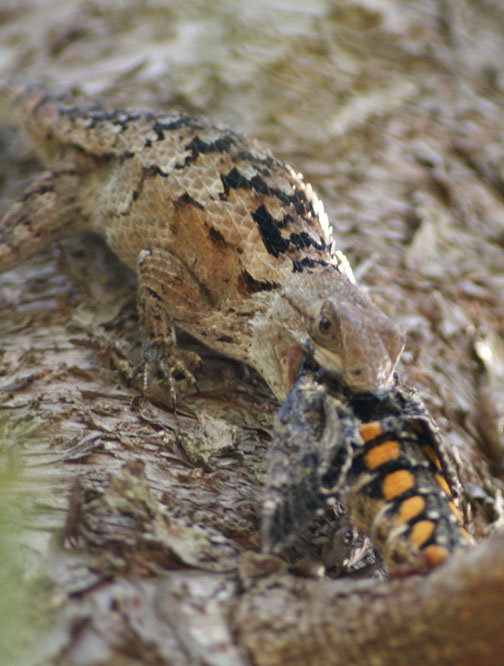Manduca sexta sexta
man-DOO-kuhmm SEX-tuh
Butler, 1877
The Carolina Sphinx

Manduca sexta sexta Brownsville, Cameron County, Texas,
prey to Scleoporus olivaceus, October 1, 2009, courtesy of Gus A. Rentfro.
Gus has a special interest in reptiles.
The Manduca sexta depicted above never had a chance to fully inflate its wings. I suspect many opportunistic lizards and other predators
take advantage of this period of limited escape mechanisms.
"Texas spiny lizards are 7.5 - 11 inches in length, and are typically grey in color with black, white, or red-brown blotching down the back. Patterns vary greatly by
locality, but the colors and pattern typically serve to be adequate camouflage against the bark of trees in its chosen habitat. The underside is usually uniformly light
grey in color, but males typically have blue patches on either side of their belly. Their scales have a distinctly spiny texture to them. They have long toes, and sharp
claws suited to climbing. Due to their spiny appearance, they are sometimes mistaken for horned lizards.
"These lizards are "diurnal and arboreal. Their preferred habitat is mesquite trees, over areas with a significant amount of ground leaf litter, but they are often found in
suburban areas basking on fences or climbing telephone poles. Typically shy and nervous, when approached they will usually retreat up a tree or flee noisily through leaf
litter on the ground. They are insectivorous, and eat a variety of beetles and other insects. Breeding occurs throughout the spring and summer months, and clutches of
eggs can be laid as many as four times a year. The Texas spiny lizard also has a peculair habit when challenged by another male for their territory. The two males will have a
push up contest, or so it seems. Both males will begin doing push ups until one of them gives up and runs away.
"Though not normally found for sale outside of its native range, as most other Sceloporus species, the Texas Spiny Lizard makes an ideal choice for a small pet lizard.
They are hardy, adapt easily to captivity, and readily consume commercially available crickets, though they do require specialized UVB & UVA lighting."
Quoted material from Wikipedia.
Remedy: I suspect these lizards would also consume larvae and pupae so a protective sleeve or cage would be needed during all rearing stages.
I am not sure if Spiny Lizards can capture prey using the "sticky tongue" method, but if you leave an emergent cage outdoors, make sure the mesh is small enough
to prevent bird beaks and lizard tongues from finding a pleasant morsel.
When I place my emergence cages outside in hardware cloth screen cages, I either put the cages up on a platform and cover them with a couple of remay cloth sleeves,
or I put the emergence cages inside a much larger hardware cloth cage so that the inner cages are several inches from the outer cage walls.
This site has been created by
Bill Oehlke at oehlkew@islandtelecom.com
Comments, suggestions and/or additional information are welcomed by Bill.
TAXONOMY:
Family: Sphingidae, Latreille, 1802
Subfamily: Sphinginae, Latreille, [1802]
Tribe: Sphingini, Latreille, 1802
Genus: Manduca Hubner, 1807 ...........
Species: sexta sexta Butler, 1877
|
MIDI MUSIC
.....It's a Wonderful World.....
copyright C. Odenkirk
ON.OFF
<bgsound src="world.mid" LOOP=FOREVER>
|
Return to Sphingidae Index
Return to Sphingini Tribe
Use your browser "Back" button to return to the previous page.
This page is brought to you by
Bill Oehlke and the
WLSS. Pages are on space rented from Bizland. If you would like
to become a "Patron of the Sphingidae Site", contact Bill.
Please send sightings/images to Bill. I will do my best to respond to
requests for identification help.
Enjoy one of nature's wonderments: Live
Saturniidae (Giant Silkmoth) cocoons.
 | 
Show appreciation for this site by clicking on flashing butterfly to the left.
The link will take you to a page with links to many insect sites. |


